German Schnitzel (Schweineschnitzel)
This post may contain affiliate links. See my disclosure policy.
This traditional German Schnitzel recipe, known as Schweineschnitzel, is just the way you know and love it from your favorite German restaurants! Made the way I learned it from my Mutti and Oma, this tutorial includes all the tips and tricks are included for making the absolute PERFECT Schnitzel!
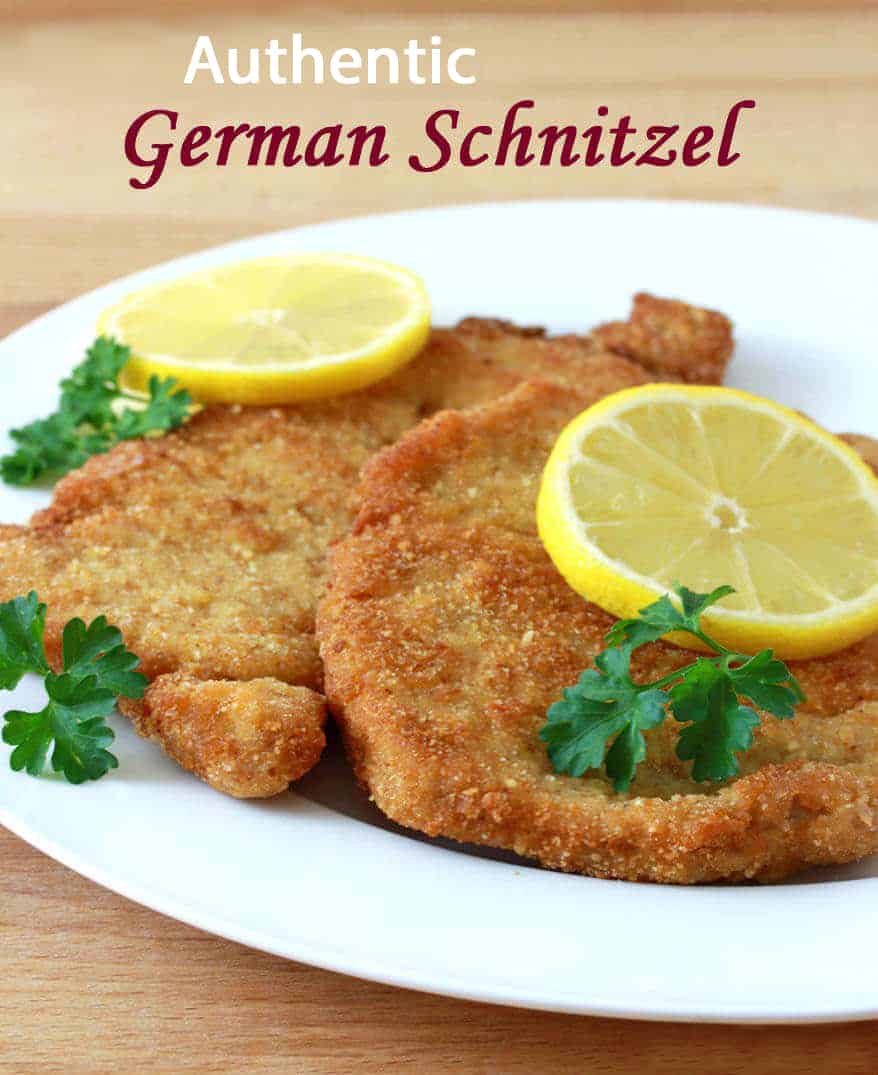
Being from Germany and as much as I love to cook, it would be unforgivably inexcusable, a total outrage, if I didn’t know how to make Schnitzel! After all, it’s one of the most quintessential German dishes. Practically every tourist to Germany has had Schnitzel and most fall in love with it.
Schnitzel vs. Wienerschnitzel: What’s the Difference?
Many people associate Schnitzel with Wienerschnitzel. However, “Wienerschnitzel” is actually a geographically protected term in Germany and Austria and can only be made with veal. German Schnitzel is prepared the same way as Austrian Wienerschnitzel, but the difference is that German Schnitzel, known as Schweineschnitzel, is made with pork instead of veal. As for where the Schnitzel originally came from…the technique of breading and frying thin cuts of meat is attributed to the Romans from around 1 BC. Another factual tidbit: Austrians will be the first to admit that Wienerschnitzel doesn’t come from Wien (Vienna).
But whether it’s Schweineschnitzel or Wienerschnitzel, when it’s perfectly breaded, perfectly fried, and perfectly crispy, practically everyone loves a good Schnitzel! And now you can make it – perfectly – in your own kitchen!
Variations
The most popular variations of Schnitzel are Jägerschnitzel (“hunter schnitzel”) which is served with mushroom gravy, Zigeunerschnitzel (“gypsy schnitzel”), served with a zesty bell pepper sauce, and Rahmschnitzel (“cream schnitzel”) served with a delicious creamy Rahm Sauce. All three are commonly found in German restaurants and are all positively delicious. If you love Schnitzel you have to try them all!
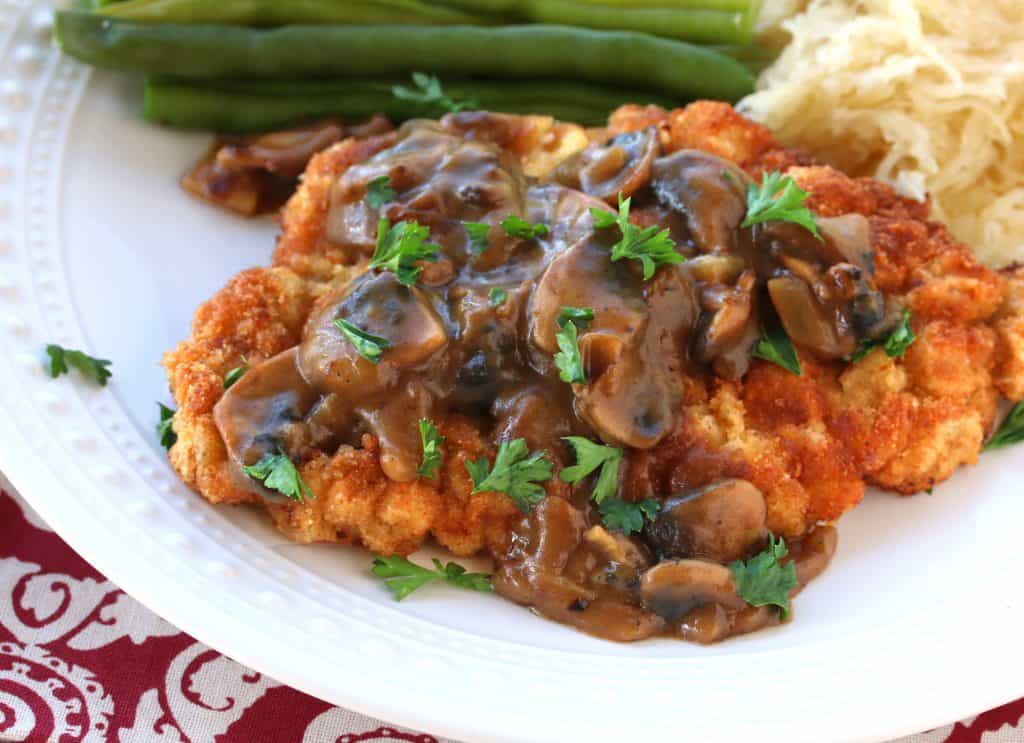
Schnitzel Recipe
Let’s get started!
Throughout the pictured recipe steps below, I’m going to share some tips and tricks with you that are important for achieving perfect results – just like the kind you get at a German restaurant.
Pro Tip 1: Pound the meat very thin, no more than 1/4 inch thick. The reason this is important is because you’ll need to fry it at high heat for a short period of time to get that perfect crispy crust without leaving the middle of the meat raw.
The easiest way to pound the pork is to lay it between two pieces of plastic wrap. Be sure to pound them using the flat side of a meat mallet. Lightly sprinkle each side with salt and pepper. Dip the pork into the flour, coating all sides.
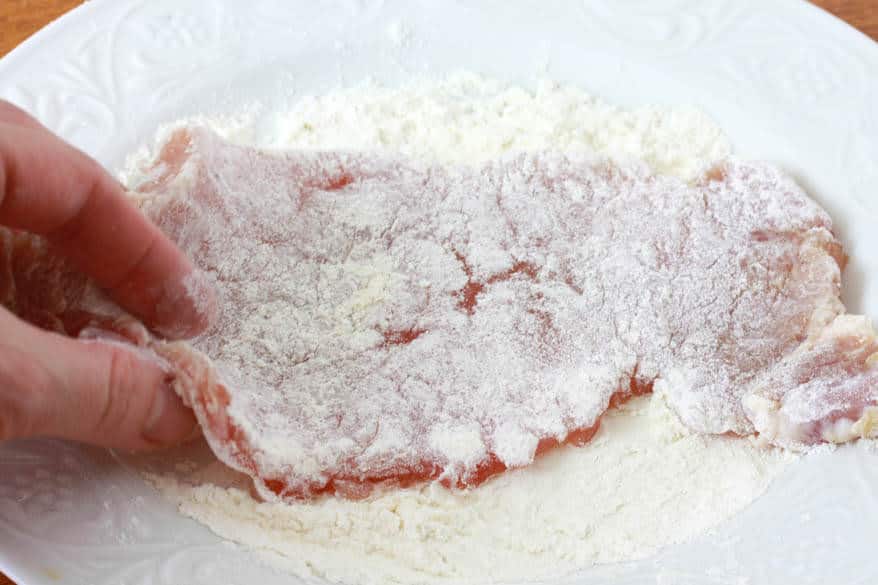
Next dip the pork into the egg mixture, coating all sides.
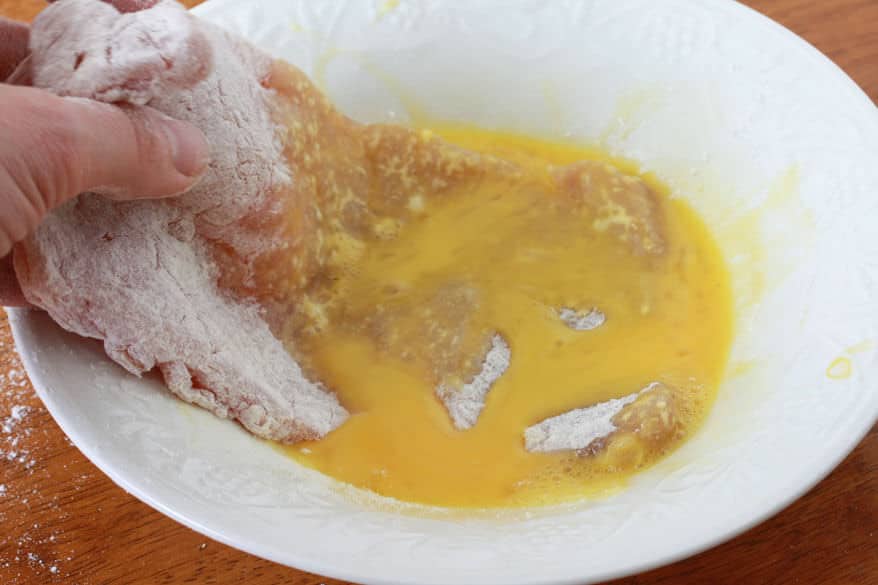
Then coat the pork with the breadcrumbs.
Pro Tip 2: Don’t press the breadcrumbs into the meat. Just softly coat the pork on both sides and all edges, and then gently shake off any excess.
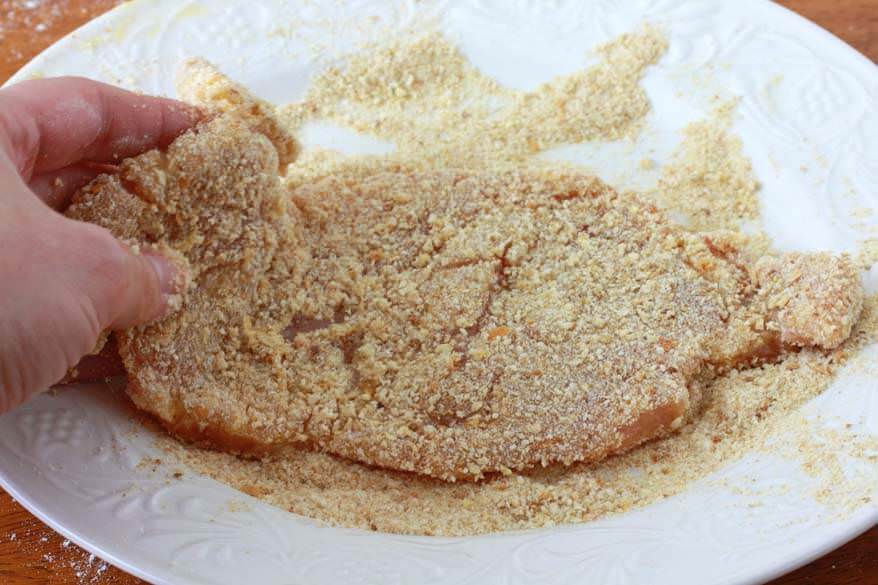
Pro Tip 3: Fry the Schnitzel immediately. Don’t let them sit in coating or the end result won’t be as crispy. You don’t need a ton of oil, but you need enough so that the Schnitzel can “swim”.
Pro Tip 4: Make sure the oil is hot enough – but not too hot. It should be around 330ºF – test it with a candy thermometer. If it’s too hot, the crust will burn before the meat is done. If it isn’t hot enough, you’ll end up with a soggy coating. When the oil is hot enough it will actually penetrate the coating less and you’ll end up with a crispy “dry” coating instead of an overly oily one. The result will be a beautifully crispy coating with a tender and juicy interior, and that’s exactly what we want.
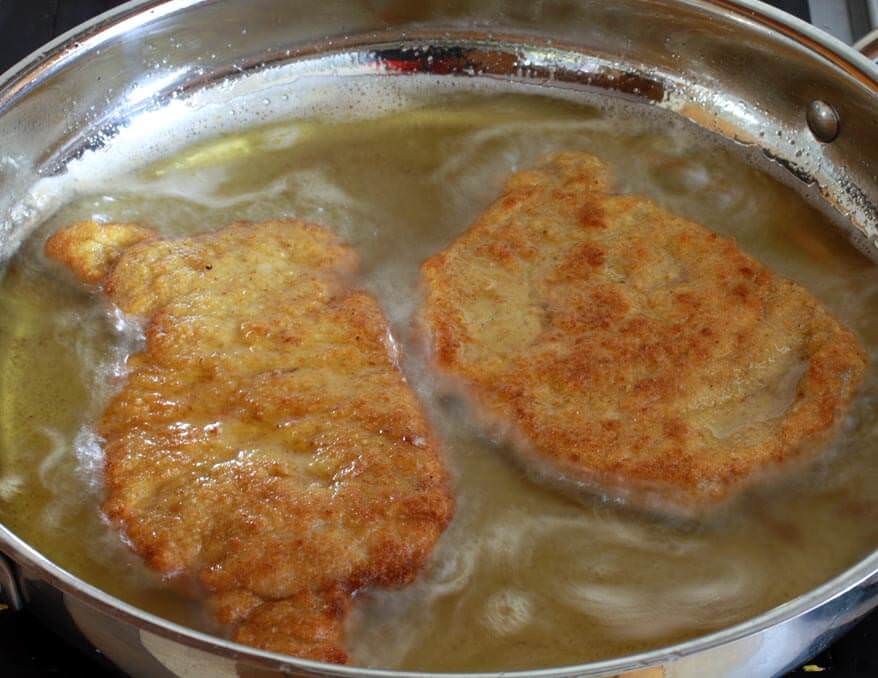
Remove the Schnitzel from the fry pan and place them briefly on a plate lined with paper towels. Transfer them to serving plates and garnish with slices of lemon and fresh parsley sprigs.
Serve immediately with French fries, Spätzle, or German potato salad and a fresh leafy green salad. See blog post below for more serving recommendations.
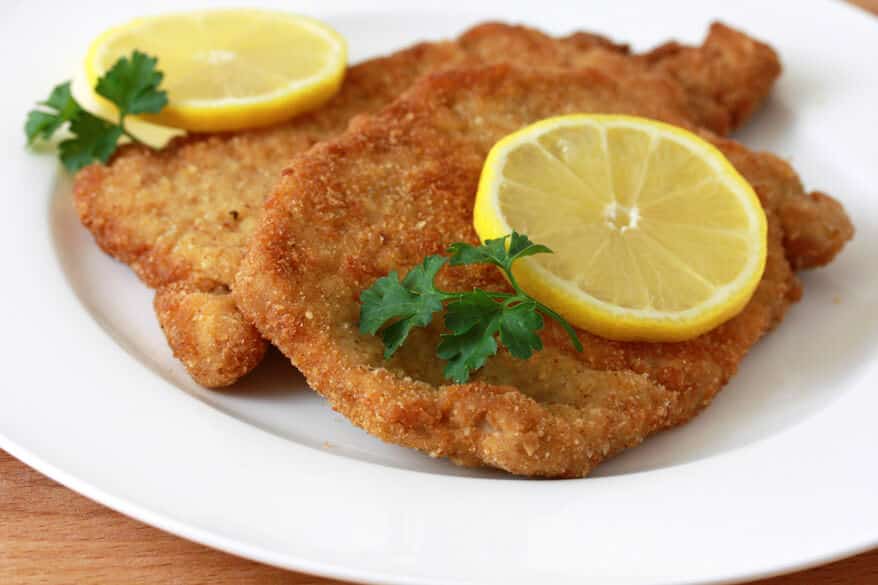
What to Serve with Schnitzel
In Germany, Schnitzel is commonly served with any of the following:
- Pommes (French fries); see my Oven Baked French Fries or Baked Potato Wedges.
- Spaetzle and gravy
- German Potato Salad
- Creamy German Cucumber Salad
- Krautsalat
- A leafy green salad
Additional serving options include mashed or roasted potatoes, Sauerkraut, Rotkohl, and roasted or steamed veggies. And if you want to pair it with some non-German sides you can serve it with classics like Creamy Coleslaw, Macaroni Salad, Classic Potato Salad, Baked Potato Wedges, Baked Beans, or Broccoli Salad.
Enjoy!
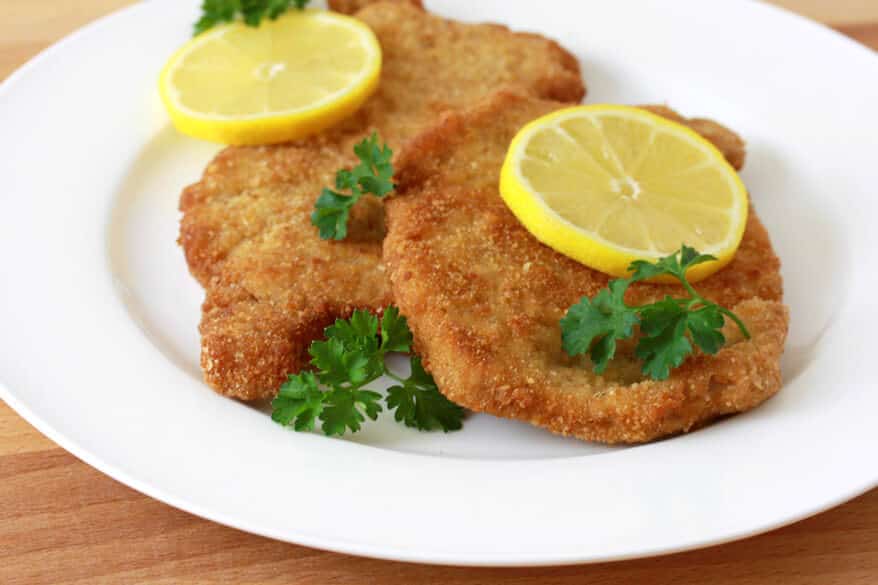
For more authentic German recipes be sure to try my:
- Sauerbraten
- Rouladen
- Schweinshaxe
- Königsberger Klopse
- Currywurst
- Käsespätzle
- Kartoffelpuffer
- Senfbraten
- Jägerschnitzel
- Maultaschen
- German Potato Soup
- Frikadellen
- German Sauerkraut Soup
Save This Recipe
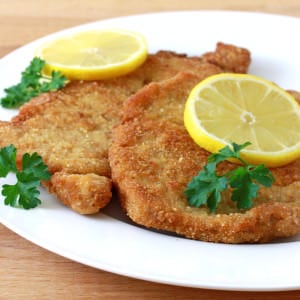
Traditional German Schnitzel (Schweineschnitzel)
Ingredients
- 4 boneless pork steaks or chops, (to make Austrian Wienerschnitzel use thin veal cutlets)
- salt and freshly ground black pepper
- 1/2 cup all-purpose flour combined with 1 teaspoon salt
- 2 large eggs, lightly beaten
- 3/4 cup plain breadcrumbs
- Oil for frying (use a neutral-tasting oil with a high smoke point)
Instructions
- Place the pork chops between two sheets of plastic wrap and pound them until just 1/4 inch thick with the flat side of a meat tenderizer. Lightly season both sides with salt and freshly ground black pepper.
- Place the flour mixture, egg, and breadcrumbs in 3 separate shallow bowls. Dip the chops in the flour, the egg, and the breadcrumbs, coating both sides and all edges at each stage. Be careful not to press the breadcrumbs into the meat. Gently shake off the excess crumbs. Don't let the schnitzel sit in the coating or they will not be as crispy once fried – fry immediately.Make sure the cooking oil is hot enough at this point (about 330 degrees F) as you don't want the Schnitzel to sit around in the coating before frying. Use enough oil so that the Schnitzels "swim" in it.Fry the Schnitzel for about 2-3 minutes on both sides until a deep golden brown. Transfer briefly to a plate lined with paper towels.
- Serve immediately with slices of fresh lemon and parsley sprigs. Serve with French fries, Spätzle or German potato salad, and a fresh leafy green salad.
Video
Nutrition
Originally published on The Daring Gourmet March 12, 2014




















My Mom, (yes she’s German, born and raised) makes the best schnitzel I’ve ever eaten. I can confirm that this recipe is authentic. The only difference, which I find to be a huge one, is my mom uses pork tenderloin and mashes it with a meat tederizer that has teeth, almost shredding it. She has made them with chops as well, and although delicious, it’s just not the same to me.
Hi Frank, thanks for your insights. This recipe (as with any Schnitzel recipe) calls for pounding the pork. There’s nothing wrong at all with using tenderloin but paying the extra $$ for a more expensive cut is really unnecessary when you’re pounding it anyway to tenderize it. Using a standard pork chop and pounding it thin will yield a perfectly tender Schnitzel. Still, I can appreciate making things the way you’re used to them, so by all means continue making it the way you know and love it best.
The perceived problem of veal is the fact of the harvesting of the calf. The calf cannot be eating any plant life at all to be called veal. When the calf is finished with moma and is ready for grazing it is hauled off the pasture in a horse carrier. Moma cow then chases the trailer all the way to the cattle guard to retrieve her calf. The cattle guard stops her from continuing and the calf is then harvested for the beautiful milk fed meat which is quite pale compared to the red grass fed meat.
Thank you. I’m Austrian and grandpa was top chef. I am 70 yo have boycotted veal after seeing them tied up in small spaces, ripped away from their mothers. Yes I eat pork, bison and was researching if pork can be substitute. Not asking anyone else to follow my opinions or choices, but I make my own. Thanks for sharing this, it needs to be said what we do torturing our food supply before we kill it. Doesn’t have to be done!
looks good
Thank you!
Um, if you heat your oil to 330 F, you’ll burn the mess out of your breading before the meat can even cook. I’m talking 5 seconds or less. I know. I just tried it. No joke.
My suggestion, set your burner at about medium, and wait till the oil is hot (NOT 330F), say 5 minutes(?) maybe? This depends on whether you’re using gas or electric. Using gas your heat time would be less.
Hi Jason, 330 F is pretty standard, in fact some people recommend 375 for Schnitzel but I think that’s too high. The key is pounding the Schnitzel so it’s thin, that way it won’t be undercooked after frying it briefly at high temperature. Once the first side is deep golden brown, quickly turn it over to fry the other side.
To master frying you must understand oil burn temp, the best way for a newbie to avoid burning the bread coating at the correct temp of 325-345 degrees is to use a high burn temp oil like peanut oil, 330 like she has said is the perfect temp but a few higher will not hurt, and if you must you can add a even mix of flour, corn starch and bread crumbs to the actual bread part of the breading, this mix will insure it takes just a small bit of time longer for the coating to be able to cook before it burns and it helps a lot when they are learning how to fry, for indeed it is a art to perfect. And always insure you let the meat swim in the oil, not sit, sitting will burn it quick and fast, and no there is no exception to this, your meat must be a inch over the bottom of the pan in which the oil is or your doing it wrong and it will burn and you will never master frying. The bottom of your pan is going to be 20-30 degrees hotter if the meat touches the point at which the burner touches the pan, a inch higher is the perfect fry temp. if you pounded your pork correctly and it is thin, you will only have to cook it 1.30-2 mins on each side and this dish is done.
And along comes a useless commenter who wants to start name-calling. I’m no “newbie”, you tool. My calibrated and verified thermometer says those temps are too high, thank you very much.
I did not call anyone a name, All I did was to explain the other details of frying other than temp alone, for temp, oil depth, type of oil, and what bases one is using for a outer coating all play part in frying anything. Instant burn with bread crumbs at 330 degrees is usually from using the wrong oil, or the wrong temp, there is not much else that can do an instant burn in the time frame you have provided. I have been cooking for my entire life and have taught many how to cook as well and that temp is standard.
He didn’t call you anything. AND a newbie is simply a term for someone who has not mastered a specific task. 330 F is the pretty much the standard for frying and you literally just said it wasn’t and gave vague subjective instructions all the while being dismissive of the author and passing yourself off as an expert when in actuality you made a “newb” mistake and someone was kind enough to help troubleshoot for you. I would call you a name but you’ve already painted a good enough picture for other readers.
Very well explained, thanks. I am going to try this recipe tonight for dinner.
And yes you did no name calling!
Yes sir just did the same thing! Agree with adjustment.
Thank you so much for posting this! I grew up in Germany but my husband never left America. So you can imagine my disappointment when I take him to a “german” restaurant and get schnitzel coated in CORNFLAKES… or greasy. Can’t wait to make him a real one soon. Will still need to visit Germany though, having trouble explaining to him that curry wurst isn’t made with real curry or what leberkaese is or a Christmas goose XD.
Awesome, Kayla! Yes, I’ve had terrible experiences at “German” restaurants here in the U.S. as well. I’m glad to hear you’ll be doing it right by making these at home. I’m sure your husband will love them. Happy Cooking!
I have yet to try the spätzle but the schnitzel was a big hit with my hubby! Thank you :)
Thank you, Rhodora, I’m thrilled to hear it! YES, you must try the Spätzle, you’ll both love it! :)
This recipe worked out great for me!
Ah, that’s perfect, Chris! So happy it all turned out well, thanks for the feedback!
I’m an American living in Cebu, Philippines. I made the pork schnitzel pretty much using your recipe. I thought they were very good. I did ask my German cousin in Frankfurt what oil his mother had used in making these same schnitzels. He believed it was Butaris. Does this sound right ? I could definitely see doing that with veal but given you have to cook pork longer wouldn’t it burn ? I would also guess as expensive as Butaris is, it wouldn’t be swimming in it. What oil do you recommend ? I used Canola but could also see using Pomace Olive oil.
Side note I used Panko style breadcrumbs and again I thought they came out very good but next time I’ll put them in the blender and it will be soon they were so good.
Hi Dave, I’m glad you enjoyed this, thank you! Butaris is a type of butter product (Butterschmalz) and many people like to use it because it has a high smoke point and tastes good. You could certainly use it but yes, it would be quite costly to buy it imported from Germany since you need a good amount of oil to cook Schnitzel properly so they’re nice and crispy. There is no right or wrong oil for frying these, it’s strictly personal preference, but I always recommend oils that have high smoke points since you’re frying at very high heat. For that reason I would not recommend olive oil.
Just so you know POMACE OLIVE. OIL has a smoke point of 460 F but it might have too much flavor. Which oil do you personally use, sunflower, vegetable oil ? I’ve veered off course and have been making it Italian style by adding to the br crumbs some Parmesan, oregano and garlic powder. I will get back on course next time if I can find the right oil, again I’m using canola.
Hi Dave, the only oils I personally use for high heat cooking are avocado (neutral flavor), coconut and lard. I use other oils for low heat cooking and for salad dressings but some oils, like canola and vegetable oil (same thing as soybean oil), I avoid entirely because they’re just not good for you. Here’s a guide to cooking we oils we published here last year that takes a look at all the various oils, why and when to use them and which ones to avoid and the reasons for it: http://www.daringgourmet.com/2015/02/13/a-comprehensive-guide-to-cooking-oils-the-good-the-bad-and-the-ugly/. For those not concerned about the health implications of oils, canola has a high smoke point and works fine for frying Schnitzel.